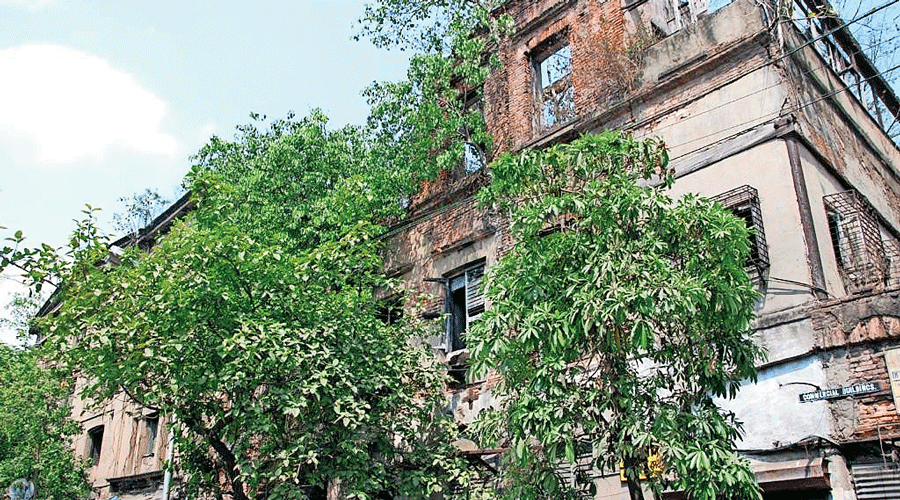If all goes to plan, one of the tallest commercial complexes in Calcutta’s central business district will rise from the rubble that now lies on a 2.77-acre plot on Strand Road.
Bengal Bonded Warehouse Ltd, established in 1838 by British merchants as a logistics hub because of its close proximity to the river and the port, has submitted a proposal to the Calcutta Municipal Corporation (CMC) to develop a new complex with two towers and a helipad that will overlook the river Hooghly.
The 184-year-old company has seen its fortunes soar and ebb in tandem with the destiny of Calcutta — once counted as the second most important city of the British empire.
If the civic authorities approve the plan, it could change the skyline of the city and the riverfront on the Strand, which has sunk into squalor and a gloomy stretch of dilapidated buildings.
Records with the company and the CMC show that there were 250-odd tenants residing in a sprawl of several structures on the rectangular plot that straddles Netaji Subhas Road in Dalhousie in the east and Strand Road in the west. The company has proposed to rehabilitate all of them in the new building.
The application to build the commercial towers has been filed under Section 412A of the CMC Act, 2017.
This proviso allows the owner of a dangerous building to pull it down and erect a new structure that must accommodate the old occupiers.
But there is an incentive: the act compensates the developer for bearing the rehabilitation cost by granting additional built-up space.
Calcutta mayor Firhad Hakim said he supported the objective behind Section 412A. “If dilapidated structures, except the heritage ones, are rebuilt, it is good for the city,” Hakim told The Telegraph.
Under the terms of the proposal submitted to the CMC, the north tower will have 23 storeys and the south tower 32.
There will be a five-storey car park from the second floor to the seventh floor, topped with a deck that can be utilised as a food and beverages (F&B) zone with a banquet offering unhindered view of the river and the two bridges across it.
The towers, which will be clad in transparent solar panels, will rise above the deck. A helipad has been proposed atop the south tower. The developer also plans to operate a 40-key business hotel in the property.
“We want to develop it as a showpiece project. Calcutta deserves something like this,” said Mahendra Kumar Jalan, principal owner and a director of Bengal Bonded Warehouse.
The company, which had become completely Indianised by 1926, has sought to develop 1 million square feet of space which will include a car park.
The plans are ambitious but a lot will depend on how much additional built-up space the civic authority is prepared to grant.
The area allocated to rehabilitate the old tenants is put at 508,000 square feet including the car park. Earlier, these people lived in dilapidated structures spread over 226,000 square feet, which have since been razed to the ground.
The new project will have to scrupulously abide by the stringent building rules that didn’t exist when these structures came up.
The plot of land has a hoary past: some of these properties were owned by the East India Company and sold in 1841 to Bengal Bonded Warehouse Association (as it was called then). British troops and regiments were housed in some of those buildings before they moved to Fort William after the sale by the Company.
One of the principal considerations before the civic authority under Section 412A would be to ascertain the cost of construction. This will determine the additional space that the developer will get to recover his cost of rehabilitation.
Bengal Bonded Warehouse has submitted the proposal and detailed the costs involved, which have been prepared by a chartered engineer. However, the CMC has asked the builder to get the numbers vetted by Jadavpur University before it takes a final call.
Sources said the proposal of Bengal Bonded could be a test case for the civic authority and may help lay down a standard operating procedure (SOP) for the approval of projects under 412A in future.
The Act says the municipal corporation can provide for “maximum floor area necessary for accommodating the erstwhile occupier or occupiers, as the case may be and additional floors as may be required for recovery of the expenses for construction after relaxation of the applicable building rules”.
One of the features proposed by the new owners is to reduce the maintenance cost by harnessing solar power. It is hoping to generate 1 mega watt, which will meet 20 per cent of the total energy needs.
Additional reporting by Subhajoy Roy











